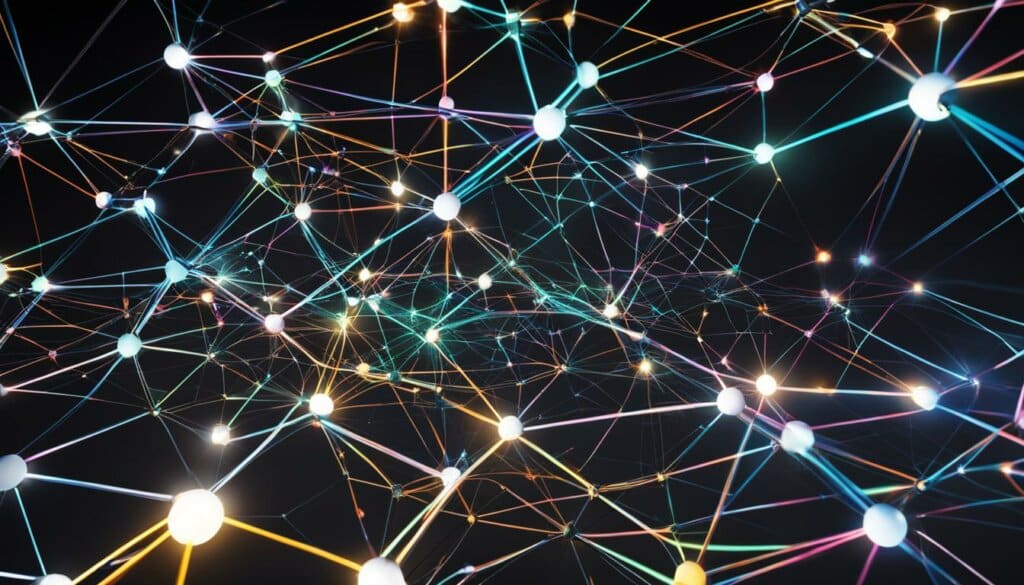Table of Contents
ChatGPT, the advanced AI-powered chatbot, relies on a sophisticated infrastructure to deliver seamless interactions. Powered by a dynamic technology stack, ChatGPT leverages generative AI and deep learning algorithms to process and generate text responses. Developed by OpenAI, this open-source platform is built on Microsoft’s proprietary Gated Recurrent Units (GRUs).
With a robust infrastructure in place, ChatGPT ensures optimal performance and efficient communication. Stay tuned to explore the role of generative AI in infrastructure-as-code, enhancing IT operations, and the benefits it brings to the cloud computing environment.
The Role of Generative AI in Infrastructure as Code
Generative AI is playing a crucial role in the development of infrastructure-as-code tools, revolutionizing the way code is generated and automated in programming languages like Python and TypeScript. One notable application of generative AI in this space is the integration of ChatGPT, a cutting-edge language model developed by OpenAI, into infrastructure-as-code platforms like Pulumi AI.
Infrastructure as code (IaC) is a methodology that enables the automation and management of IT infrastructure using machine-readable code. With the help of generative AI, ChatGPT has been trained to generate infrastructure code based on natural language prompts, significantly simplifying and expediting the deployment process.
By harnessing generative AI, infrastructure-as-code platforms leverage the power of ChatGPT to convert high-level human instructions into functional code. This not only reduces the complexity and time required for deployments but also enhances the efficiency and reliability of IT operations.
An example of how generative AI is transforming infrastructure as code is the use of ChatGPT to automatically generate cloud resource configurations. Rather than manually specifying intricate details, developers can interact with ChatGPT using natural language prompts, allowing the AI model to generate the corresponding infrastructure code.
“ChatGPT’s integration into infrastructure-as-code tools has the potential to revolutionize the way we manage and automate IT infrastructure. By leveraging generative AI, developers can streamline the code generation process, abstracting away low-level implementation details and focusing on high-level instructions.”
The table below highlights the key benefits of utilizing generative AI in infrastructure as code:
| Benefits of Generative AI in Infrastructure as Code |
|---|
| Simplifies code generation and deployment processes |
| Reduces human error and enhances code reliability |
| Streamlines IT operations and improves efficiency |
| Enables automation of complex infrastructure configurations |
| Facilitates collaboration between developers and operations teams |
Generative AI, as exemplified by ChatGPT, empowers developers to leverage the capabilities of infrastructure as code in a more intuitive and efficient manner. By bridging the gap between natural language understanding and code generation, generative AI is transforming the way we design, deploy, and manage IT infrastructure.
Enhancing IT Operations with ChatGPT
ChatGPT, with its advanced technology stack, offers significant benefits to IT operations by automating tasks and providing efficient help desk support. Through its ability to understand user intentions based on natural language prompts, ChatGPT generates contextually appropriate responses. Leveraging machine learning techniques, the platform continuously improves its accuracy and effectiveness over time. This enables it to assist with various aspects of IT operations, including technical troubleshooting, IT alert notifications, and automation of repetitive tasks, freeing up IT staff to focus on more complex issues.
Automating Routine Tasks
One of the key advantages of ChatGPT in IT operations is its ability to automate routine tasks. By understanding user queries and prompts, ChatGPT can perform tasks such as user account management, software installations, and system maintenance with minimal human intervention. This not only increases efficiency but also reduces the risk of errors typically associated with manual execution.
Providing Help Desk Support
ChatGPT is a valuable tool for providing help desk support in IT operations. It can efficiently handle common user inquiries and provide prompt resolutions. The platform’s natural language processing capabilities enable it to understand complex user issues and generate appropriate responses, offering users a seamless support experience. Moreover, ChatGPT can learn from historical data and user feedback, allowing it to continuously enhance its performance.
Facilitating Technical Troubleshooting
“ChatGPT’s robust machine learning framework makes it an invaluable asset in technical troubleshooting. By analyzing user queries and applying its knowledge base, ChatGPT can accurately identify root causes and recommend suitable solutions. This significantly reduces the time required to resolve complex technical issues and minimizes service disruptions.”
Streamlining IT Alert Notifications
In IT operations, timely alerts and notifications are crucial for proactively addressing system anomalies or vulnerabilities. ChatGPT can be integrated into alert management systems, enhancing the efficiency of communication and response. By autonomously analyzing alerts and providing context-aware notifications, ChatGPT enables IT teams to quickly identify and mitigate potential issues, ensuring smooth operations and minimizing downtime.
Automating Repetitive Tasks
In many IT operations, there are numerous repetitive tasks that can be automated to improve efficiency. ChatGPT can be programmed to handle routine tasks such as log analysis, report generation, and backups. By automating these time-consuming tasks, IT staff can focus their efforts on more strategic initiatives and complex projects.
Maximizing IT Operations Efficiency
By leveraging ChatGPT’s technology stack, IT operations can achieve higher efficiency levels and optimize resource allocation. The automation of tasks and the availability of instant help desk support streamline operations, reducing response times and increasing overall productivity. This ultimately leads to a more efficient IT environment and enables organizations to deliver better services to their users.
| Benefits of ChatGPT in IT Operations | |
|---|---|
| Automation of routine tasks | ✓ |
| Efficient help desk support | ✓ |
| Accurate technical troubleshooting | ✓ |
| Improved IT alert notifications | ✓ |
| Automation of repetitive tasks | ✓ |
Benefits of ChatGPT in IT Operations
ChatGPT offers several benefits in IT operations, including cost reduction, increased efficiency, and improved customer service. By automating routine tasks and providing real-time support, it can enhance the overall user experience and satisfaction.
The platform’s ability to learn from user intent and respond appropriately can help increase the efficiency and efficacy of helpdesk support and technical troubleshooting. With its AI-driven chatbot capabilities, ChatGPT can handle customer queries and provide personalized assistance, reducing the need for manual intervention and minimizing response times.
ChatGPT’s natural language processing capabilities allow it to understand customer needs and provide accurate and relevant information. By analyzing customer conversations and feedback, the system can continuously improve its responses, ensuring better customer service over time.
Customer Service Benefits
One of the significant advantages of using ChatGPT in IT operations is the improvement in customer service. The AI-driven chatbot can handle a high volume of customer inquiries simultaneously, ensuring prompt and efficient responses.
- Enhanced response times: ChatGPT can provide real-time support and reduce the response times for customer queries, resulting in greater satisfaction and improved customer experience.
- 24/7 availability: Unlike human agents, ChatGPT is available round the clock, enabling customers to get assistance whenever they need it, regardless of the time zone or location.
- Consistent and accurate information: ChatGPT can provide consistent and accurate information to customers, reducing the chances of errors or misinformation that can occur in human interactions.
By leveraging its programming language prowess and AI capabilities, ChatGPT can deliver reliable and efficient customer service, ultimately leading to increased customer loyalty and trust.
Efficiency and Cost Reduction
Implementing ChatGPT in IT operations can also lead to improved efficiency and cost reduction for businesses.
- Automated routine tasks: ChatGPT can automate repetitive and mundane tasks, freeing up human agents to focus on more complex and critical issues. This leads to increased efficiency and productivity within the IT support team.
- Reduction in operational costs: By automating tasks and streamlining workflows, ChatGPT can help reduce operational costs associated with IT support, allowing organizations to optimize their resources efficiently.
- Scalability: ChatGPT can handle a high volume of customer inquiries simultaneously without compromising on the quality of service. This scalability ensures that businesses can effectively manage customer support during peak periods and avoid bottlenecks.
Overall, incorporating ChatGPT into IT operations can have a transformative impact, resulting in significant benefits such as improved customer service, increased efficiency, and cost reduction.
How ChatGPT Works
ChatGPT operates using a state-of-the-art framework based on a transformer-based neural network. This advanced technology enables it to process and generate text responses with remarkable accuracy and fluency. The platform is trained on extensive and diverse text datasets, allowing it to generate well-written material across various topics and contexts.
One of the key features of ChatGPT is its ability to employ attention methods. These methods allow the model to focus on relevant parts of the conversation, enhancing the relevance and context of its responses. By understanding the intricacies of the input and attentively processing the information, ChatGPT is capable of providing more tailored and accurate replies.
Memory modules also play a crucial role in ChatGPT’s functioning. They enable the model to retain and recall information from previous messages, ensuring consistency and coherence in the conversation. This memory-based approach enhances the conversational experience and helps ChatGPT deliver responses that build upon prior interactions.
To continually improve its performance, ChatGPT combines supervised learning and reinforcement learning techniques. Through the iterative process of training and fine-tuning, the platform learns from human feedback and adapts its responses to better align with user expectations. This iterative learning process enhances the quality and relevance of the outputs generated by ChatGPT, ensuring a more satisfying conversational experience.

Utilizing the power of natural language processing and transformer-based neural networks, ChatGPT represents a significant advancement in AI-driven conversation. It demonstrates OpenAI’s commitment to pushing the boundaries of what is possible with language models, and its potential applications extend beyond chatbots to various fields that benefit from human-like interaction and understanding.
ChatGPT in Cloud Computing
While not directly involved in cloud computing, ChatGPT can be leveraged with cloud technology to offer various services, enhancing modern IT operations and improving customer service experiences. By integrating ChatGPT into chatbots and virtual assistants running on cloud servers, businesses can ensure scalable and highly available access to virtual assistants.
One of the key advantages of using ChatGPT in the cloud computing environment is its ability to automate customer service inquiries. With its natural language processing capabilities, ChatGPT can analyze and understand user queries, providing accurate and timely responses. This helps in streamlining customer support processes and reducing response times.
Furthermore, ChatGPT can handle a range of duties, such as making appointments and organizing schedules. Virtual assistants powered by ChatGPT can efficiently manage these tasks, freeing up valuable time for employees to focus on more strategic responsibilities.
By incorporating ChatGPT into cloud-based virtual assistants, businesses can benefit from its advanced language processing capabilities, enhancing user interactions and providing personalized experiences. These virtual assistants can adapt to individual user preferences and learn from previous interactions, allowing for a more intuitive and tailored user experience.
Here is a table summarizing the benefits of using ChatGPT in the cloud computing environment:
| Benefits of ChatGPT in Cloud Computing |
|---|
| Automates customer service inquiries |
| Handles appointment scheduling and organizing |
| Enhances user interactions and experiences |
| Provides personalized and tailored responses |
ChatGPT, when integrated with cloud technology, contributes to the modernization of IT operations and improves overall customer service experiences. Its capabilities in automating tasks and providing scalable virtual assistance make it a valuable asset for businesses looking to enhance their cloud-based operations.
Conclusion
In conclusion, ChatGPT is an innovative AI-driven chatbot that enhances the chatbot experience through natural language processing and generation. By leveraging deep learning algorithms and machine learning techniques, ChatGPT offers a range of benefits in the chatbot runtime environment.
One of the key advantages of using ChatGPT is the increased efficiency it brings to IT operations. By automating routine tasks and providing real-time support, ChatGPT streamlines processes and saves valuable time for IT professionals.
Furthermore, the use of ChatGPT can lead to cost reduction, as it eliminates the need for additional human resources for customer service and helpdesk support. This AI-powered chatbot can handle customer inquiries and troubleshoot technical issues, improving overall customer service satisfaction.
By deploying ChatGPT in the cloud computing environment, its accessibility and capabilities are further enhanced. It can be integrated into chatbots and virtual assistants, providing scalable and highly available access for a seamless user experience.
FAQ
What does ChatGPT run on?
ChatGPT runs on a sophisticated AI infrastructure, leveraging generative AI and deep learning algorithms to process and produce text responses.
What is the role of generative AI in infrastructure as code?
Generative AI is being applied to infrastructure-as-code tools to automate the generation of code based on natural language prompts, reducing complexity and improving IT operations efficiency.
How can ChatGPT enhance IT operations?
ChatGPT can automate routine tasks, provide help desk support, assist with technical troubleshooting, IT alert notifications, and automate repetitive tasks, allowing IT staff to focus on complex issues.
What are the benefits of using ChatGPT in IT operations?
ChatGPT offers benefits such as cost reduction, increased efficiency, improved customer service, learning from user intent, and providing real-time support.
How does ChatGPT work?
ChatGPT processes and produces text responses using a transformer-based neural network and combines supervised learning and reinforcement learning techniques to improve the quality of its outputs.
How is ChatGPT used in cloud computing?
Although not directly involved in cloud computing, ChatGPT can be integrated into chatbots and virtual assistants running on cloud servers to automate customer service inquiries and provide various services.
What are the benefits of using ChatGPT?
ChatGPT offers benefits such as increased efficiency, reduced costs, improved customer service, and the ability to streamline IT operations.













